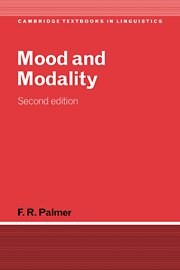Book contents
- Frontmatter
- Contents
- Preface
- Note on the text
- List of abbreviations
- 1 Introduction
- 2 Modal systems: Propositional modality
- 3 Modal systems: Event modality
- 4 Modal systems and modal verbs
- 5 Indicative and subjunctive
- 6 Realis and Irrealis
- 7 Subjunctive and irrealis
- 8 Past tense as modal
- References
- Language index
- General index
7 - Subjunctive and irrealis
Published online by Cambridge University Press: 05 June 2012
- Frontmatter
- Contents
- Preface
- Note on the text
- List of abbreviations
- 1 Introduction
- 2 Modal systems: Propositional modality
- 3 Modal systems: Event modality
- 4 Modal systems and modal verbs
- 5 Indicative and subjunctive
- 6 Realis and Irrealis
- 7 Subjunctive and irrealis
- 8 Past tense as modal
- References
- Language index
- General index
Summary
This chapter will deal with a number of issues relating to both subjunctive and irrealis that have not been addressed, or not fully addressed, in the preceding two.
Similarities and differences
The decision to use different terminology for indicative/subjunctive and to deal with them in separate chapters rests upon a number of considerations.
It is partly a result of different traditions. The terms ‘indicative’ and ‘subjunctive’ are the traditional terms used in the description of the classical and modern languages of Europe, though, not unreasonably, they have been used by many scholars for other languages. According to Bybee et al. (1994: 236) the earliest use of the terms ‘realis’ and ‘irrealis’ noted in an extensive corpus is to be found in the description of the Australian language Maung in Capell and Hinch (1970). These terms have been preferred by scholars working in the Native American languages and in the languages of the Pacific, particularly those of Papua New Guinea. However, since it is unlikely that the scholars working in these languages were unaware of the classical tradition, it is probable that this decision was influenced by perceived differences in the nature of the data being investigated.
One possible difference that might be suggested is that mood in the European languages is a morphosyntactic category closely integrated with person, number, tense and voice. The four categories are not independently marked, the form being simultaneously the marker of all the grammatical categories, as well as of the lexical item.
Information
- Type
- Chapter
- Information
- Mood and Modality , pp. 185 - 202Publisher: Cambridge University PressPrint publication year: 2001
